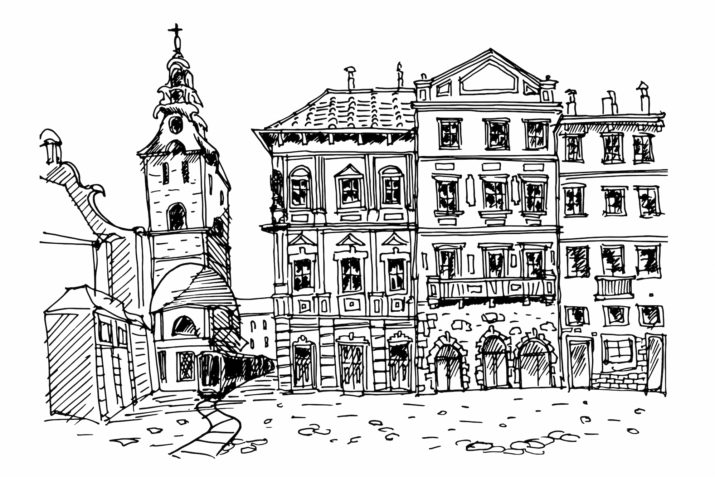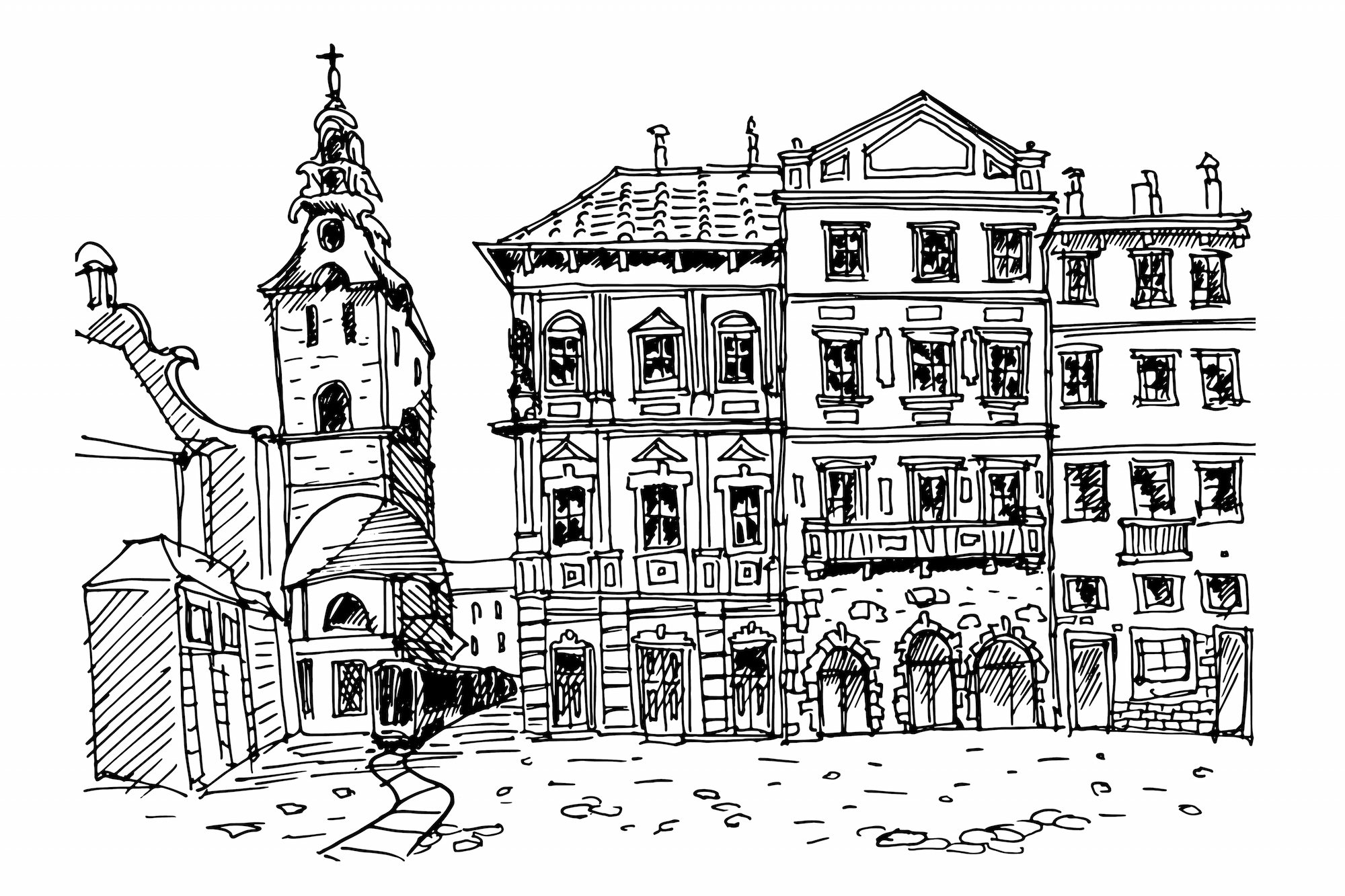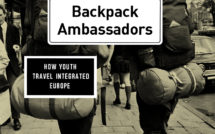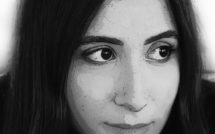

This is part of our special feature on Tourism: People, Places & Mobilities.
I see only the two small feet of a child, who had just been previously feigning sleep, walk across the stage below a hovering curtain. They are met at the wings by a pair of adult shoes when the lights turn on for intermission. Some audience members begin to make their way to the lobby, looking intermittently up at the gilded ceiling where a series of painted Muses radiate around the chandelier. Most of the rest are already staring at phones, and few notice the utmost rows of the last balcony where behind me sit a few dozen youthful soldiers donned in fatigues, equal parts male and female, caps withdrawn in their laps. They remain seated, one trading comments with a fellow seated at the opposite end of the row.
They and everyone else—the child and audience, orchestra and light crew, Sharpless and Pinkerton—are one thousand kilometers away from the war in the eastern provinces of Luhansk and Donetsk. In Lviv, a western Ukrainian city only a little closer to Kiev than it is to Vienna, these soldiers on leave from the front are some of the only reminders of the war that has now in its third year has killed over 10,000 Ukrainians. A visitor to the city would be forgiven for not realizing the country is at war at all.
This fin-de-siecle opera house, built by the Austro-Hungarians for a city near the furthest eastern extents of its empire, sits at the end of the main avenue above a buried river that used to flow outside the medieval walls of the city, some of which still remains. It will stage twice as many ballets and operas each month as my home city in the United States does in a year. The Seredmistia, or city center, is on the UNESCO World Heritage list, and where I usually see soldiers like these, walking in paired columns behind a commanding officer between visits to different sites. Beyond (often Polish) statuary, these are mostly religious in nature: an Armenian church, the hollowed out void in the streetscape where once stood a Jewish synagogue—now a memorial—and the many Greek-Catholic and Orthodox churches and cathedral. When given time on their own during daylight hours, many of these soldiers choose to walk the city’s parks, congregating at benches with cheap beers from the shops rather than sit at the many park restaurants with covered tables serving cold drafts. I see the more solitary ones sitting on park benches, headphones on, watching the promenades. Others choose Puccini. In the evenings, they drink with each other in the basement bars of the Old City, some into oblivion. Those actually from Lviv field the many questions about the warfront of very curious and very proud friends who buy their drinks. Here no one seems to trust the news about the war from the Ukrainian government.
The majority of the Armed Forces of Ukraine hail from the central oblasts (provinces), and for most of these soldiers it is their first visit to this cultural capital and oft-declared “soul” of Ukraine; some may not even speak the language. Besides their presence, what visual evidence here of the war that does remain is mostly limited to memorials; the rest are fundraisers. Down the avenue from the opera house beside a towering statue of the national poet Taras Schevchenko, volunteers in a small military tent solicit donations for the warfront. Their occasional live performances of patriotic songs, sung quietly into a microphone and sometimes accompanied by electronic keyboard, are blasted into the plaza by a large sound system. (One can sometimes hear music from closer tents in the opera house during the Sunday matinées, but these are not usually war-related awareness campaigns, rather marketing events or disproportionately amp-ed buskers.) During the previous winter, a rotating crew of soldiers maintained a small camp in the city’s main square, living and sleeping as the soldiers did at the front, and where locals would join them for cigarettes around a campfire. A plexi-glass donation box shaped like a tank accepts donations at the door of one restaurant. Behind the large ARMY SOS letters and a Facebook logo and link to the organization’s page on the outside, it is stuffed with bills.
Even restaurants have been victims of the daily barrage of cyber-attacks that have crippled institutions across the country. The most recent, the ransomware known as “Petya,” shuttered two of the city’s most popular cafes. Handwritten “Closed” signs are taped to the front doors of both with no dates provided for re-opening. This is not to say the privations of everyday Leopolitans—the inhabitants of Lviv, from its Latin name Leopolis—are banal. The war has wreaked havoc on the economy. Since the currency lost three times its value against the euro in as many years, the average monthly wage for a professional worker now stands somewhere between 100-200 euros. The European Union may have just passed legislation allowing Ukrainians visa-free travel to Schengen countries, but few can even afford to travel abroad.
In the aisles of every major church in the city, votive candles are placed before poster boards featuring photographic arrays of the fallen. In the Saints Peter and Paul Garrison Church, hundreds of white origami constructions hang above elaborate arrangements of munitions, flowers, and traditionally embroidered textiles that usually accompany these photographs. One such tableau centers upon a birch tree cross between flanking icons of the Theotokos and Christ Pantocrator set before the façade of an olive canvas military tent (and where leans against it the blood and soil nationalist flag). A mandylion superimposed on the national flag with the words ‘God and Ukraine above all’ hangs from it. At the base, expired ordnance is spread like flower petals around larger pieces of twisted metal, and a canteen pierced by bullets rests next to some pendent rosary beads emerging from the hole of a mortar barrel.
So too outside the churches. In the small square down the street from my apartment, a large black memorial banner had been draped over the first and second floor windows (beside an even larger real estate bulletin that covered the third story as well). Before it was replaced with an advertisement for a local bank, I would see this sepia-toned photograph of a soldier at the front, poised above the seated statue of historian and politician Mykhailo Hrushevsky at the center of the square. He wore a seamed winter cap and had a bulky jacket underneath his camouflage, a Kalashnikov suspended from his neck. The photo was closely cropped—his stance suggested his unseen arms were around the backs of fellow soldiers. The text below it read:
Dmytro Godzenko
The Legendary “Godzilla”
17.11.1966 – 31.03.2016
He died for our freedom.
We will remember him forever.
Less prominent are the small, dedicatory granite placards of fallen soldiers placed outside the doors of the schools they attended only a few years earlier. The war continues to claim the life of a soldier per day despite its frequent designation as a ‘low-intensity’ or ‘frozen’ conflict. Every day, a village funeral.
The attitude in the city has changed much since the Russian seizure of Crimea. Lviv welcomed its first war refugees—a few thousand Crimean Tatars—immediately after hostilities began. Local organizations popped up to help the new arrivals and stocked warehouses with donated goods. Others did not even consider these Tatars as Ukrainians. Though neither of the same religion nor language, Tatars do share a current antipathy towards the Russian Federation. Their previous population in Lviv had been twenty. Then came many more thousands from the east when the war in the Donbas began. There are currently 1.6 million internally displaced persons in the country.
The earlier patriotic demonstrations have begun to wane (young people, for instance, generally did not go out or attend parties when the subsequent war in the Donbas broke out), though the city is yet full of men and women wearing the traditional vyshyvanka shirt, and the national flag still flies everywhere—usually next to the EU banner. One rather poignant example of this lingering patriotism is to hear the Russian language sometimes spoken in the streets as a kind gesture to those who have fled the east and for whom Russian is their primary, if not only, language. In the capital Kiev and cities elsewhere, where Russian and Ukrainian are spoken interchangeably, the change has been rather to speak and hear more Ukrainian than before.
Though we are in the cultural heartland of Ukraine, none of the attitudes towards the war are universal. Some Leopolitans wonder why patriotic Ukrainians from the west or center of the country even need to fight and die for the “ungrateful” (or separationist) citizens in the east, while others volunteer for the war effort. I have endured, for the sheer sake of curiosity, the confused diatribes of a self-described “arch-nationalist” but otherwise gentle-mannered skinhead from Manchester against the supposed lenient response of his own and European governments towards the “Muslim invasion of Europe.” Five years ago he decided to make a home for himself in Lviv for this reason, joining local far right groups (of whom he only spoke in the first-person plural) that are now sending fighters to the east.[1]
I mean not to focus on one member of the small expat community here but have rather used his example to point out the obvious fact that the incompatible narratives and ambitions of pro-Ukrainian and pro-Russian nationalists are sprung from the same potted ideology, and that one should see him as a foil to the other, rather ordinary people I have shared tables with who have told me without much conviction they were unwilling to frequent establishments with Russian speaking staff. Here was an Englishman who believed here, in Lviv, he could be proud of the history and cultural legacy of a country—and, like myself, completely neglect to learn the local language. The only common sentiment seemingly shared between the population here, whether welcoming or surly, politically apathetic or fiercely patriotic, is that people are tired of the war: tired of not knowing what is actually happening in the east, tired of not knowing when or how it will end, or the geo-political fate of the Crimea. An acute case of fatigue and uncertainty now has a way of undermining both confidence in the government and hopes for a brighter future. For some, the prospect of ever joining the European Union and being something other than just a sacrificial lamb between “Europe” and “Russia” is as dismal as their own government’s perceived ability to fight corruption—a pre-requisite for the former. Looking beyond the Atlantic, there is neither much consolation to be found there amongst that erstwhile ally, where an American president seems as willing to kiss the ass of the Russian president as Leopolitans are to wipe theirs with it—the toilet paper rolls sold in the market square feature Putin’s printed visage on every leaf[2].
The footprint of the Lviv Latin Cathedral is a little aslant of the gridded street plan of the Old Town. I don’t know why. This does make for a few interesting spaces around the cathedral, especially behind the apse where the buttresses fan out into a squqre adjacent to the small, domed Boim Family Chapel. Tourists take pictures of this building for no other reason than its sandstone has darkened over time to a near-black; street performers naturally gravitate here. A few weeks ago I and a similarly entranced soldier watched one perform the entirety of Vivaldi’s Four Seasons solo on an accordion outside its walls. We exchanged looks of disbelief before depositing small bills for the performance. I wanted to try to talk to him, but he sauntered off in another direction.
I thought of him the last time I had left Lviv, when it seemed all of those marching columns of soldiers had converged at the train station—the other prominent Austro-Hungarian public building in the city. Bus coaches fought taxis for space in the lanes in front of a wide grass median where resides the sleeping bags and belongings of an ever-changing camp of the Roma population. I presumed somewhere in that company of fatigues carrying all manner of duffel bags and rucksacks was the same soldier. I was taking a day trip westward to the Carpathians with some friends, they preparing for the twenty-plus hour train ride to a war in the east, all of us on Soviet-built trains now painted Ukrainian blue and yellow.
John Lindner is a writer and architect from Texas currently living Lviv.
Photo: Lviv, Shutterstock
References:
[1] This, he claimed, was a more active role than their usual fare of—as I was meant to understand it—football hooliganism and assaulting Turkish tourists or any white women wearing a hijab. The latter two were evidence of this—switching historical gears—new Ottoman vanguard.
[2] The face of the former has yet, to my knowledge, appeared on the toilet rolls, though a local brewery on the same square—aptly named Pravda—has honored him by lending his name to their new Imperial Mexican Lager. They say it pairs best with dark meats.
Published on September 6, 2017.




